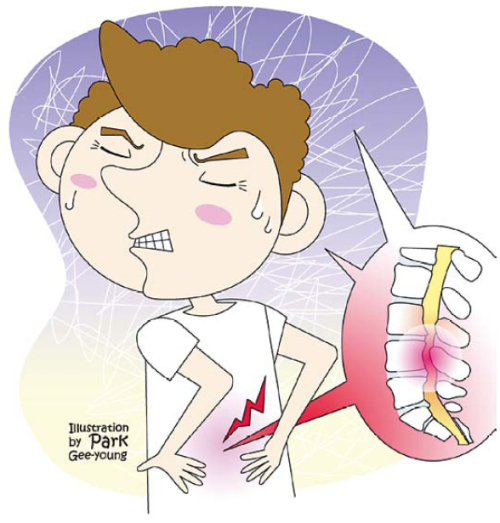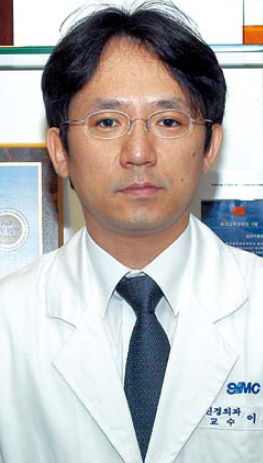Lumbar spinal stenosis is a degenerative spinal disorder that develops when the foramina of the lumbar vertebrae become narrowed resulting in compression of the nerve roots.
This compression of the spinal canal causes back pain and neurological symptoms in the lower limbs. Spinal stenosis may be congenital (idiopathic) or acquired (degenerative). The main symptoms of the disease are limping and back pain.
Patients experience a pulling sensation and tingling in the legs after a short walk, resulting in a repetitive pattern of short walks followed by periods of rest. A hunched posture will relieve the pain whereas standing up straight and stretching will make it worse. A pause after a walk helps the symptoms disappear quickly.

Pressure on the nerve roots and veins caused by lumbar stenosis obstructs the flow of cerebrospinal fluid and blood. Some experts claim that congestion of the veins may deprive the nerve roots of oxygen. Being able to walk after squatting and feeling pain after walking are classic symptoms. In the past, the condition was diagnosed by radiography or CT but more recently, the use of MRI has spread.
What is the prognosis for spinal stenosis? According to a thesis survey, only 15 percent of patients experience exacerbation of their condition, 15 percent experience improvement, and 70 percent do not change. The results show that deterioration in symptoms is not the key factor in cases of stenosis. “Quality of life” is the primary concern in deciding whether to treat spinal stenosis conservatively or surgically.
The goals of treatment are pain relief and the preservation of function. Safety, effectiveness, cost, and other factors need to be considered when deciding on treatment strategy.
Conservative treatment can be opted for if there is no neuroparalysis, when the symptoms range from slight to moderate, or when the patient’s general condition is incompatible with surgery. Rest is an option. The period of rest can last up to two weeks in cases of back pain. In cases of acute or subacute pain, epidural steroid injections are effective.
However, in patients with neuroparalytic symptoms, the outcome tends to be poor. Caution is warranted with patients on aspirin and diabetics (who may experience problems regulating their blood sugar).
Non-steroid anti-inflammatory drugs (NSAIDs), analgesics (pain killers), muscle relaxants, prostaglandin E1 (PGE1) and anti depressants are commonly prescribed. These days, prostaglandins are prescribed more often than NSAIDs.
The compression of nerve roots and blood vessels can cause functional neurological problems. Prostaglandins are vasodilators (they expand the blood vessels) which attenuate the tenderness and paraesthesia in the lower limbs, and mitigate the claudication.
Currently, surgery is only undertaken in cases of neurological deficiency, severe pain and functional impairment that makes everyday life difficult. The goal of surgery is to improve function, decrease pain, and prevent exacerbation of the neurological involvement. Success ― a good or satisfactory outcome ― is reported in 85 percent of patients who undergo lumbar decompression surgery.
Abnormal mobility of the degenerative segment can be corrected by fusion which eliminates the instability, stops the progression of spondylolisthesis and prevents the recurrence of stenosis.
What is the difference between the outcomes of conservative and surgical treatment? More of those with moderate or severe stenosis improved if they are operated on; however, more also get worse. Similarly, walking improves in more surgical patients, but it also got worse in more of them. After a 10 year observation period, both groups showed similar outcomes. The implications of these results need to be taken into account.
To summarize, 10-30 percent of patients who did not receive any treatment for spinal stenosis showed improvement, compared to 20-50 percent of patients who received conservative treatment and 60-90 percent of those who were operated on.
However, 25 percent of surgical patients got worse compared to 15 percent of those who received no treatment and 10 percent who underwent conservative treatment. I want to stress that it is important to know before deciding on a treatment strategy that spinal stenosis does not cause absolute paralysis and that surgery does not always relieve symptoms.
This compression of the spinal canal causes back pain and neurological symptoms in the lower limbs. Spinal stenosis may be congenital (idiopathic) or acquired (degenerative). The main symptoms of the disease are limping and back pain.
Patients experience a pulling sensation and tingling in the legs after a short walk, resulting in a repetitive pattern of short walks followed by periods of rest. A hunched posture will relieve the pain whereas standing up straight and stretching will make it worse. A pause after a walk helps the symptoms disappear quickly.

Pressure on the nerve roots and veins caused by lumbar stenosis obstructs the flow of cerebrospinal fluid and blood. Some experts claim that congestion of the veins may deprive the nerve roots of oxygen. Being able to walk after squatting and feeling pain after walking are classic symptoms. In the past, the condition was diagnosed by radiography or CT but more recently, the use of MRI has spread.
What is the prognosis for spinal stenosis? According to a thesis survey, only 15 percent of patients experience exacerbation of their condition, 15 percent experience improvement, and 70 percent do not change. The results show that deterioration in symptoms is not the key factor in cases of stenosis. “Quality of life” is the primary concern in deciding whether to treat spinal stenosis conservatively or surgically.
The goals of treatment are pain relief and the preservation of function. Safety, effectiveness, cost, and other factors need to be considered when deciding on treatment strategy.
Conservative treatment can be opted for if there is no neuroparalysis, when the symptoms range from slight to moderate, or when the patient’s general condition is incompatible with surgery. Rest is an option. The period of rest can last up to two weeks in cases of back pain. In cases of acute or subacute pain, epidural steroid injections are effective.
However, in patients with neuroparalytic symptoms, the outcome tends to be poor. Caution is warranted with patients on aspirin and diabetics (who may experience problems regulating their blood sugar).
Non-steroid anti-inflammatory drugs (NSAIDs), analgesics (pain killers), muscle relaxants, prostaglandin E1 (PGE1) and anti depressants are commonly prescribed. These days, prostaglandins are prescribed more often than NSAIDs.
The compression of nerve roots and blood vessels can cause functional neurological problems. Prostaglandins are vasodilators (they expand the blood vessels) which attenuate the tenderness and paraesthesia in the lower limbs, and mitigate the claudication.
Currently, surgery is only undertaken in cases of neurological deficiency, severe pain and functional impairment that makes everyday life difficult. The goal of surgery is to improve function, decrease pain, and prevent exacerbation of the neurological involvement. Success ― a good or satisfactory outcome ― is reported in 85 percent of patients who undergo lumbar decompression surgery.
Abnormal mobility of the degenerative segment can be corrected by fusion which eliminates the instability, stops the progression of spondylolisthesis and prevents the recurrence of stenosis.
What is the difference between the outcomes of conservative and surgical treatment? More of those with moderate or severe stenosis improved if they are operated on; however, more also get worse. Similarly, walking improves in more surgical patients, but it also got worse in more of them. After a 10 year observation period, both groups showed similar outcomes. The implications of these results need to be taken into account.
To summarize, 10-30 percent of patients who did not receive any treatment for spinal stenosis showed improvement, compared to 20-50 percent of patients who received conservative treatment and 60-90 percent of those who were operated on.
However, 25 percent of surgical patients got worse compared to 15 percent of those who received no treatment and 10 percent who underwent conservative treatment. I want to stress that it is important to know before deciding on a treatment strategy that spinal stenosis does not cause absolute paralysis and that surgery does not always relieve symptoms.

By Lee Sun-ho
The author is a neurosurgeon at Department of Neurosurgery at Spine Center of Samsung Medical Center and assistant professor of Sungkyunkwan University School of Medicine. ― Ed.



![[Exclusive] Korean military set to ban iPhones over 'security' concerns](http://res.heraldm.com/phpwas/restmb_idxmake.php?idx=644&simg=/content/image/2024/04/23/20240423050599_0.jpg&u=20240423183955)

![[Graphic News] 77% of young Koreans still financially dependent](http://res.heraldm.com/phpwas/restmb_idxmake.php?idx=644&simg=/content/image/2024/04/22/20240422050762_0.gif&u=)



![[Pressure points] Leggings in public: Fashion statement or social faux pas?](http://res.heraldm.com/phpwas/restmb_idxmake.php?idx=644&simg=/content/image/2024/04/23/20240423050669_0.jpg&u=)









